Innovative Digital Workspace: A Project Management Plan & Report
VerifiedAdded on 2023/06/08
|26
|6681
|85
Report
AI Summary
This report explores the concept of an innovative digital workspace, focusing on project management principles and their application in a real-world context, specifically Marks & Spencer. It covers the stages of a project life cycle, factors influencing the completion of a project management plan, and various research methods used in project management. The report includes a detailed project management plan (PMP) with a work breakdown structure (WBS) and Gantt chart, outlining the timeframe for completing the research. It also discusses the execution of the business project, communication of findings, data presentation, and analysis to draw meaningful conclusions and recommendations. The report concludes with a reflection on the values of undertaking the business project to fulfill predefined objectives, emphasizing the importance of workplace transformation and the implementation of innovative digital techniques for organizational growth and efficiency.

Unit 6 Managing a Successful Business Project
Paraphrase This Document
Need a fresh take? Get an instant paraphrase of this document with our AI Paraphraser
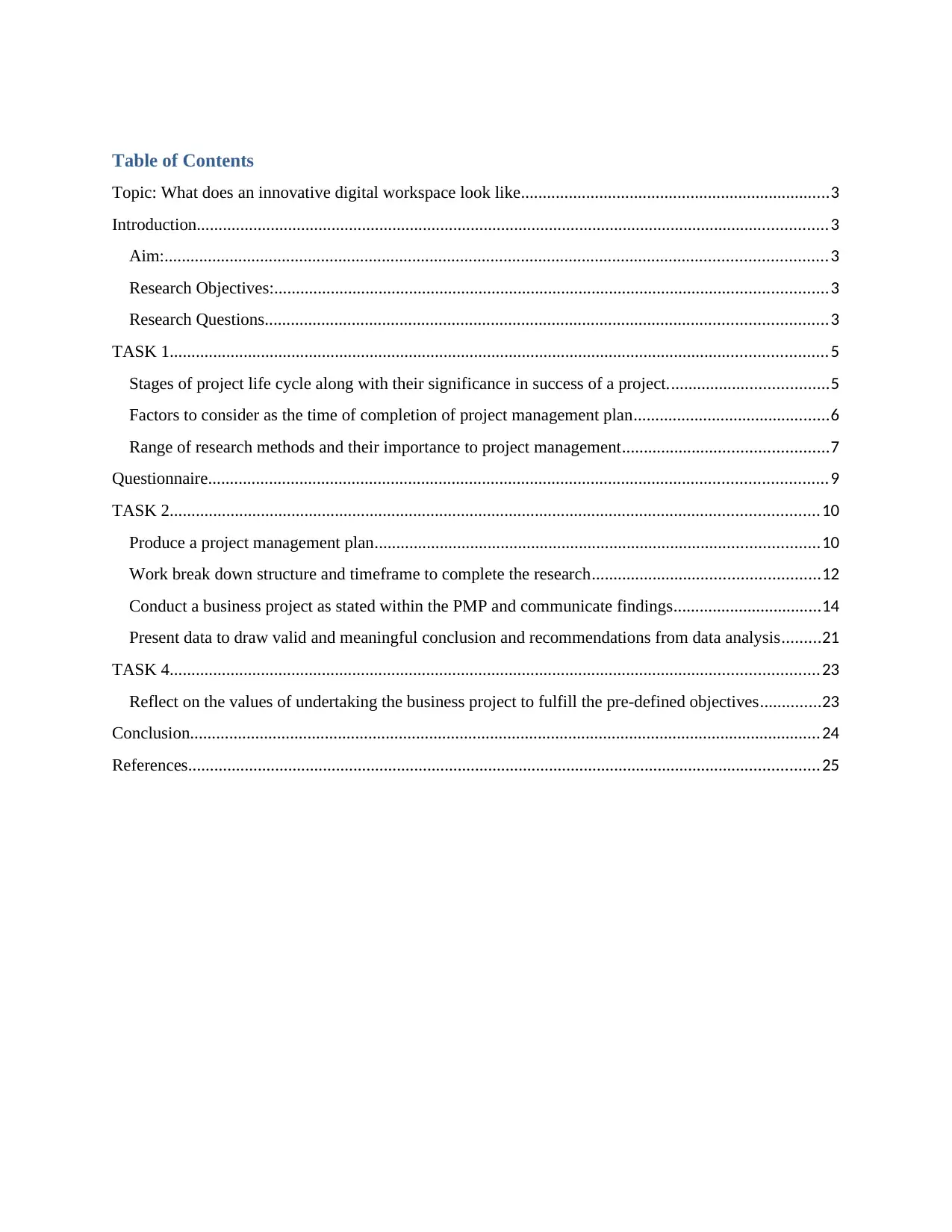
Table of Contents
Topic: What does an innovative digital workspace look like.......................................................................3
Introduction.................................................................................................................................................3
Aim:........................................................................................................................................................3
Research Objectives:...............................................................................................................................3
Research Questions.................................................................................................................................3
TASK 1.......................................................................................................................................................5
Stages of project life cycle along with their significance in success of a project.....................................5
Factors to consider as the time of completion of project management plan.............................................6
Range of research methods and their importance to project management...............................................7
Questionnaire..............................................................................................................................................9
TASK 2.....................................................................................................................................................10
Produce a project management plan......................................................................................................10
Work break down structure and timeframe to complete the research....................................................12
Conduct a business project as stated within the PMP and communicate findings..................................14
Present data to draw valid and meaningful conclusion and recommendations from data analysis.........21
TASK 4.....................................................................................................................................................23
Reflect on the values of undertaking the business project to fulfill the pre-defined objectives..............23
Conclusion.................................................................................................................................................24
References.................................................................................................................................................25
Topic: What does an innovative digital workspace look like.......................................................................3
Introduction.................................................................................................................................................3
Aim:........................................................................................................................................................3
Research Objectives:...............................................................................................................................3
Research Questions.................................................................................................................................3
TASK 1.......................................................................................................................................................5
Stages of project life cycle along with their significance in success of a project.....................................5
Factors to consider as the time of completion of project management plan.............................................6
Range of research methods and their importance to project management...............................................7
Questionnaire..............................................................................................................................................9
TASK 2.....................................................................................................................................................10
Produce a project management plan......................................................................................................10
Work break down structure and timeframe to complete the research....................................................12
Conduct a business project as stated within the PMP and communicate findings..................................14
Present data to draw valid and meaningful conclusion and recommendations from data analysis.........21
TASK 4.....................................................................................................................................................23
Reflect on the values of undertaking the business project to fulfill the pre-defined objectives..............23
Conclusion.................................................................................................................................................24
References.................................................................................................................................................25
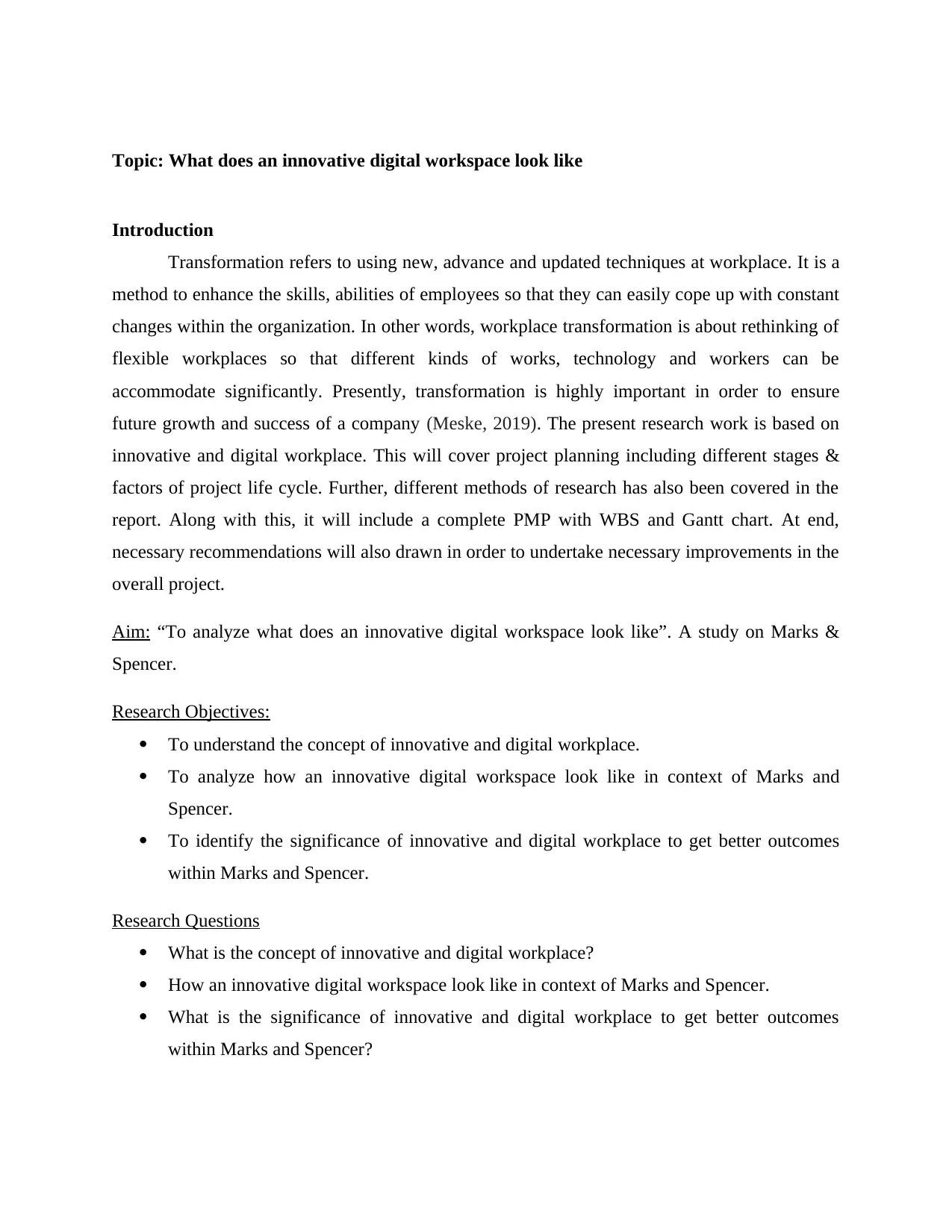
Topic: What does an innovative digital workspace look like
Introduction
Transformation refers to using new, advance and updated techniques at workplace. It is a
method to enhance the skills, abilities of employees so that they can easily cope up with constant
changes within the organization. In other words, workplace transformation is about rethinking of
flexible workplaces so that different kinds of works, technology and workers can be
accommodate significantly. Presently, transformation is highly important in order to ensure
future growth and success of a company (Meske, 2019). The present research work is based on
innovative and digital workplace. This will cover project planning including different stages &
factors of project life cycle. Further, different methods of research has also been covered in the
report. Along with this, it will include a complete PMP with WBS and Gantt chart. At end,
necessary recommendations will also drawn in order to undertake necessary improvements in the
overall project.
Aim: “To analyze what does an innovative digital workspace look like”. A study on Marks &
Spencer.
Research Objectives:
To understand the concept of innovative and digital workplace.
To analyze how an innovative digital workspace look like in context of Marks and
Spencer.
To identify the significance of innovative and digital workplace to get better outcomes
within Marks and Spencer.
Research Questions
What is the concept of innovative and digital workplace?
How an innovative digital workspace look like in context of Marks and Spencer.
What is the significance of innovative and digital workplace to get better outcomes
within Marks and Spencer?
Introduction
Transformation refers to using new, advance and updated techniques at workplace. It is a
method to enhance the skills, abilities of employees so that they can easily cope up with constant
changes within the organization. In other words, workplace transformation is about rethinking of
flexible workplaces so that different kinds of works, technology and workers can be
accommodate significantly. Presently, transformation is highly important in order to ensure
future growth and success of a company (Meske, 2019). The present research work is based on
innovative and digital workplace. This will cover project planning including different stages &
factors of project life cycle. Further, different methods of research has also been covered in the
report. Along with this, it will include a complete PMP with WBS and Gantt chart. At end,
necessary recommendations will also drawn in order to undertake necessary improvements in the
overall project.
Aim: “To analyze what does an innovative digital workspace look like”. A study on Marks &
Spencer.
Research Objectives:
To understand the concept of innovative and digital workplace.
To analyze how an innovative digital workspace look like in context of Marks and
Spencer.
To identify the significance of innovative and digital workplace to get better outcomes
within Marks and Spencer.
Research Questions
What is the concept of innovative and digital workplace?
How an innovative digital workspace look like in context of Marks and Spencer.
What is the significance of innovative and digital workplace to get better outcomes
within Marks and Spencer?
⊘ This is a preview!⊘
Do you want full access?
Subscribe today to unlock all pages.

Trusted by 1+ million students worldwide
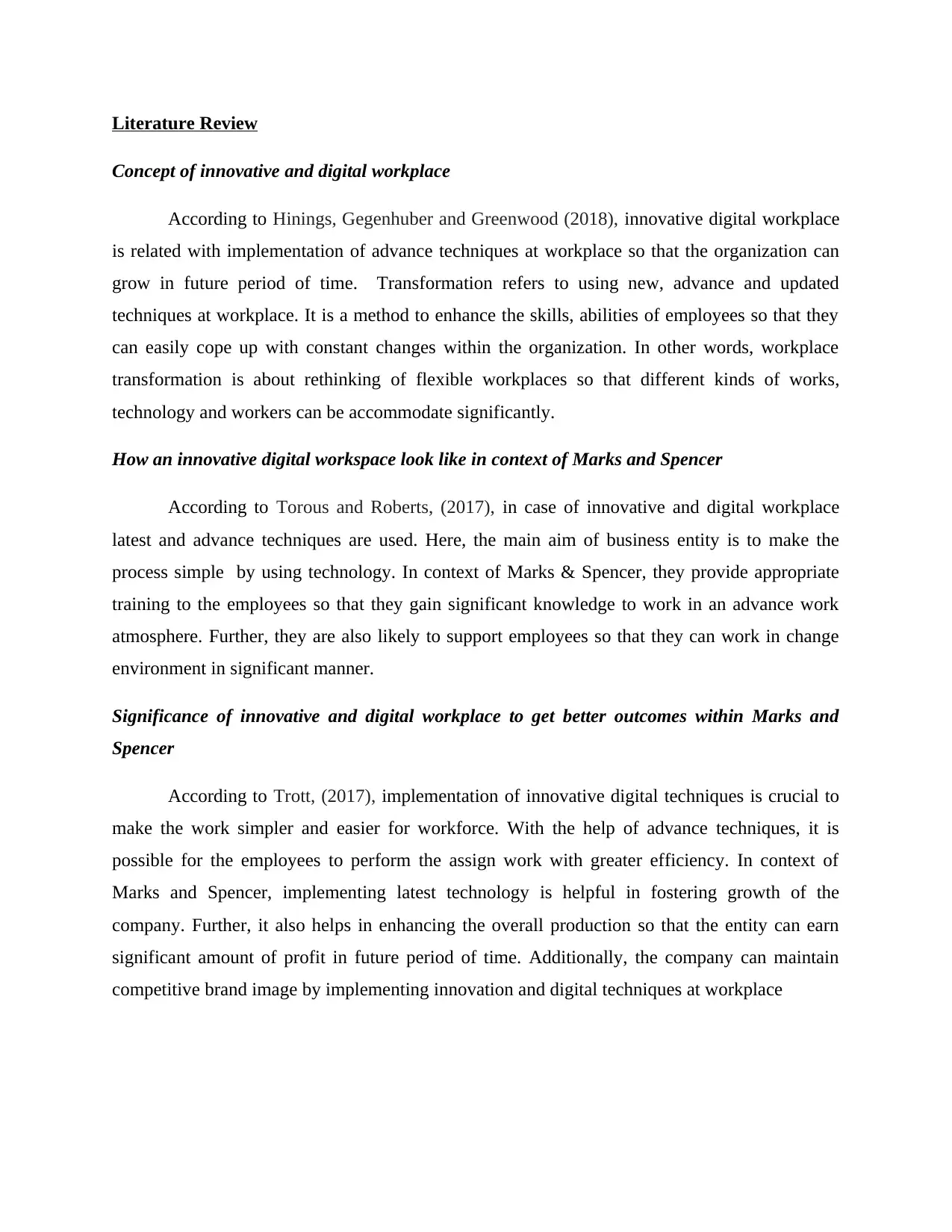
Literature Review
Concept of innovative and digital workplace
According to Hinings, Gegenhuber and Greenwood (2018), innovative digital workplace
is related with implementation of advance techniques at workplace so that the organization can
grow in future period of time. Transformation refers to using new, advance and updated
techniques at workplace. It is a method to enhance the skills, abilities of employees so that they
can easily cope up with constant changes within the organization. In other words, workplace
transformation is about rethinking of flexible workplaces so that different kinds of works,
technology and workers can be accommodate significantly.
How an innovative digital workspace look like in context of Marks and Spencer
According to Torous and Roberts, (2017), in case of innovative and digital workplace
latest and advance techniques are used. Here, the main aim of business entity is to make the
process simple by using technology. In context of Marks & Spencer, they provide appropriate
training to the employees so that they gain significant knowledge to work in an advance work
atmosphere. Further, they are also likely to support employees so that they can work in change
environment in significant manner.
Significance of innovative and digital workplace to get better outcomes within Marks and
Spencer
According to Trott, (2017), implementation of innovative digital techniques is crucial to
make the work simpler and easier for workforce. With the help of advance techniques, it is
possible for the employees to perform the assign work with greater efficiency. In context of
Marks and Spencer, implementing latest technology is helpful in fostering growth of the
company. Further, it also helps in enhancing the overall production so that the entity can earn
significant amount of profit in future period of time. Additionally, the company can maintain
competitive brand image by implementing innovation and digital techniques at workplace
Concept of innovative and digital workplace
According to Hinings, Gegenhuber and Greenwood (2018), innovative digital workplace
is related with implementation of advance techniques at workplace so that the organization can
grow in future period of time. Transformation refers to using new, advance and updated
techniques at workplace. It is a method to enhance the skills, abilities of employees so that they
can easily cope up with constant changes within the organization. In other words, workplace
transformation is about rethinking of flexible workplaces so that different kinds of works,
technology and workers can be accommodate significantly.
How an innovative digital workspace look like in context of Marks and Spencer
According to Torous and Roberts, (2017), in case of innovative and digital workplace
latest and advance techniques are used. Here, the main aim of business entity is to make the
process simple by using technology. In context of Marks & Spencer, they provide appropriate
training to the employees so that they gain significant knowledge to work in an advance work
atmosphere. Further, they are also likely to support employees so that they can work in change
environment in significant manner.
Significance of innovative and digital workplace to get better outcomes within Marks and
Spencer
According to Trott, (2017), implementation of innovative digital techniques is crucial to
make the work simpler and easier for workforce. With the help of advance techniques, it is
possible for the employees to perform the assign work with greater efficiency. In context of
Marks and Spencer, implementing latest technology is helpful in fostering growth of the
company. Further, it also helps in enhancing the overall production so that the entity can earn
significant amount of profit in future period of time. Additionally, the company can maintain
competitive brand image by implementing innovation and digital techniques at workplace
Paraphrase This Document
Need a fresh take? Get an instant paraphrase of this document with our AI Paraphraser

TASK 1
Stages of project life cycle along with their significance in success of a project.
Project management life cycle shows higher level processes in order to deliver a project
successfully. Through effective project management, it is possible to make significant use of the
available resources. Further, it also helps in minimizing the wastage out of the project. To
complete a project successfully, it is imperative to follow the project life cycle in significant
manner. This cycle includes four major steps such as initiation, planning, execution and closure.
The project life cycle is related with inclusion of these four steps from starting of project to
closure (Galli, 2018). These all steps are interrelated with each-other and need to complete
appropriately to complete the project work successfully. In present context, different steps of
PLC are mentioned as under:
Initiation Phase: It is the first step of PLC where it is important to identify the need of
business, problem and opportunities. For this purpose, one can do brainstorming and accept the
ideas of team members to resolve the issue or get the opportunity. Here, an objective is found out
and further the feasibility of such objective is evaluated significantly. In addition, the major
deliverables of the project have also been identified during this phase (Azhar, Khan and Zafar,
2019). In context of current situation, the project managers is going to undertake a project based
on workplace transformation. This project will be carried out to facilitate transformation at
workplace so that the business entity can grow & succeed in future period of time. The
respective project will help in enhancing the overall skills and capabilities of workforce in
significant manner.
Planning Phase: This is the second step of PLC where the larger project is break down
into smaller components. Here, team is build and scheduled is prepared for the completion of
project work in timely manner. By creating small goals, it is possible to complete the entire
project successfully in future period of time. Here, smaller goals are likely to motivate the
project manager and team members to put efforts for the success of entire project (Vuorinen and
Martinsuo, 2018). In context of the existing project, there is requirement to undertake planning
by breaking down the entire project into smaller components. Through planning, the project
manager will be able to assign different duties to different people for proceeding with the project
further.
Stages of project life cycle along with their significance in success of a project.
Project management life cycle shows higher level processes in order to deliver a project
successfully. Through effective project management, it is possible to make significant use of the
available resources. Further, it also helps in minimizing the wastage out of the project. To
complete a project successfully, it is imperative to follow the project life cycle in significant
manner. This cycle includes four major steps such as initiation, planning, execution and closure.
The project life cycle is related with inclusion of these four steps from starting of project to
closure (Galli, 2018). These all steps are interrelated with each-other and need to complete
appropriately to complete the project work successfully. In present context, different steps of
PLC are mentioned as under:
Initiation Phase: It is the first step of PLC where it is important to identify the need of
business, problem and opportunities. For this purpose, one can do brainstorming and accept the
ideas of team members to resolve the issue or get the opportunity. Here, an objective is found out
and further the feasibility of such objective is evaluated significantly. In addition, the major
deliverables of the project have also been identified during this phase (Azhar, Khan and Zafar,
2019). In context of current situation, the project managers is going to undertake a project based
on workplace transformation. This project will be carried out to facilitate transformation at
workplace so that the business entity can grow & succeed in future period of time. The
respective project will help in enhancing the overall skills and capabilities of workforce in
significant manner.
Planning Phase: This is the second step of PLC where the larger project is break down
into smaller components. Here, team is build and scheduled is prepared for the completion of
project work in timely manner. By creating small goals, it is possible to complete the entire
project successfully in future period of time. Here, smaller goals are likely to motivate the
project manager and team members to put efforts for the success of entire project (Vuorinen and
Martinsuo, 2018). In context of the existing project, there is requirement to undertake planning
by breaking down the entire project into smaller components. Through planning, the project
manager will be able to assign different duties to different people for proceeding with the project
further.
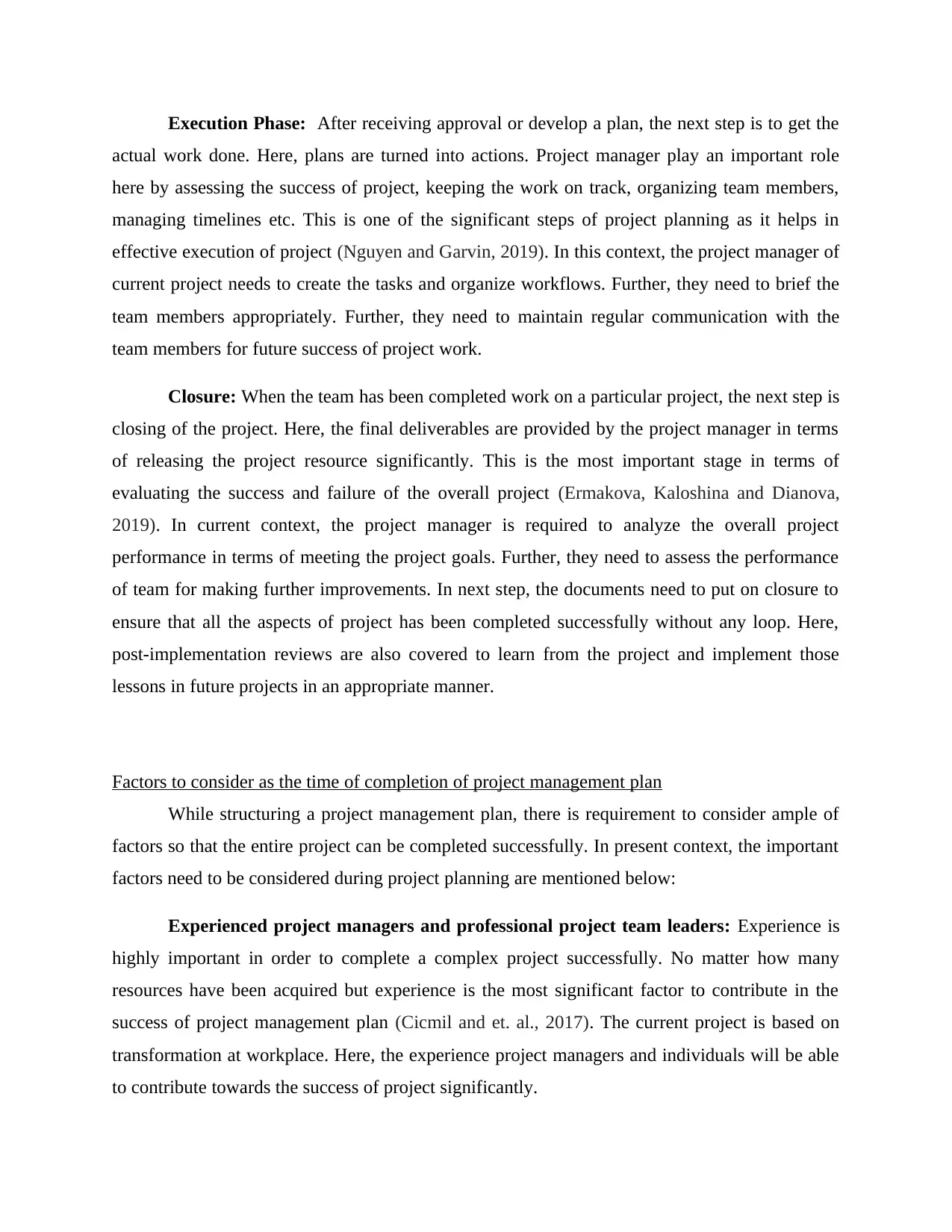
Execution Phase: After receiving approval or develop a plan, the next step is to get the
actual work done. Here, plans are turned into actions. Project manager play an important role
here by assessing the success of project, keeping the work on track, organizing team members,
managing timelines etc. This is one of the significant steps of project planning as it helps in
effective execution of project (Nguyen and Garvin, 2019). In this context, the project manager of
current project needs to create the tasks and organize workflows. Further, they need to brief the
team members appropriately. Further, they need to maintain regular communication with the
team members for future success of project work.
Closure: When the team has been completed work on a particular project, the next step is
closing of the project. Here, the final deliverables are provided by the project manager in terms
of releasing the project resource significantly. This is the most important stage in terms of
evaluating the success and failure of the overall project (Ermakova, Kaloshina and Dianova,
2019). In current context, the project manager is required to analyze the overall project
performance in terms of meeting the project goals. Further, they need to assess the performance
of team for making further improvements. In next step, the documents need to put on closure to
ensure that all the aspects of project has been completed successfully without any loop. Here,
post-implementation reviews are also covered to learn from the project and implement those
lessons in future projects in an appropriate manner.
Factors to consider as the time of completion of project management plan
While structuring a project management plan, there is requirement to consider ample of
factors so that the entire project can be completed successfully. In present context, the important
factors need to be considered during project planning are mentioned below:
Experienced project managers and professional project team leaders: Experience is
highly important in order to complete a complex project successfully. No matter how many
resources have been acquired but experience is the most significant factor to contribute in the
success of project management plan (Cicmil and et. al., 2017). The current project is based on
transformation at workplace. Here, the experience project managers and individuals will be able
to contribute towards the success of project significantly.
actual work done. Here, plans are turned into actions. Project manager play an important role
here by assessing the success of project, keeping the work on track, organizing team members,
managing timelines etc. This is one of the significant steps of project planning as it helps in
effective execution of project (Nguyen and Garvin, 2019). In this context, the project manager of
current project needs to create the tasks and organize workflows. Further, they need to brief the
team members appropriately. Further, they need to maintain regular communication with the
team members for future success of project work.
Closure: When the team has been completed work on a particular project, the next step is
closing of the project. Here, the final deliverables are provided by the project manager in terms
of releasing the project resource significantly. This is the most important stage in terms of
evaluating the success and failure of the overall project (Ermakova, Kaloshina and Dianova,
2019). In current context, the project manager is required to analyze the overall project
performance in terms of meeting the project goals. Further, they need to assess the performance
of team for making further improvements. In next step, the documents need to put on closure to
ensure that all the aspects of project has been completed successfully without any loop. Here,
post-implementation reviews are also covered to learn from the project and implement those
lessons in future projects in an appropriate manner.
Factors to consider as the time of completion of project management plan
While structuring a project management plan, there is requirement to consider ample of
factors so that the entire project can be completed successfully. In present context, the important
factors need to be considered during project planning are mentioned below:
Experienced project managers and professional project team leaders: Experience is
highly important in order to complete a complex project successfully. No matter how many
resources have been acquired but experience is the most significant factor to contribute in the
success of project management plan (Cicmil and et. al., 2017). The current project is based on
transformation at workplace. Here, the experience project managers and individuals will be able
to contribute towards the success of project significantly.
⊘ This is a preview!⊘
Do you want full access?
Subscribe today to unlock all pages.

Trusted by 1+ million students worldwide
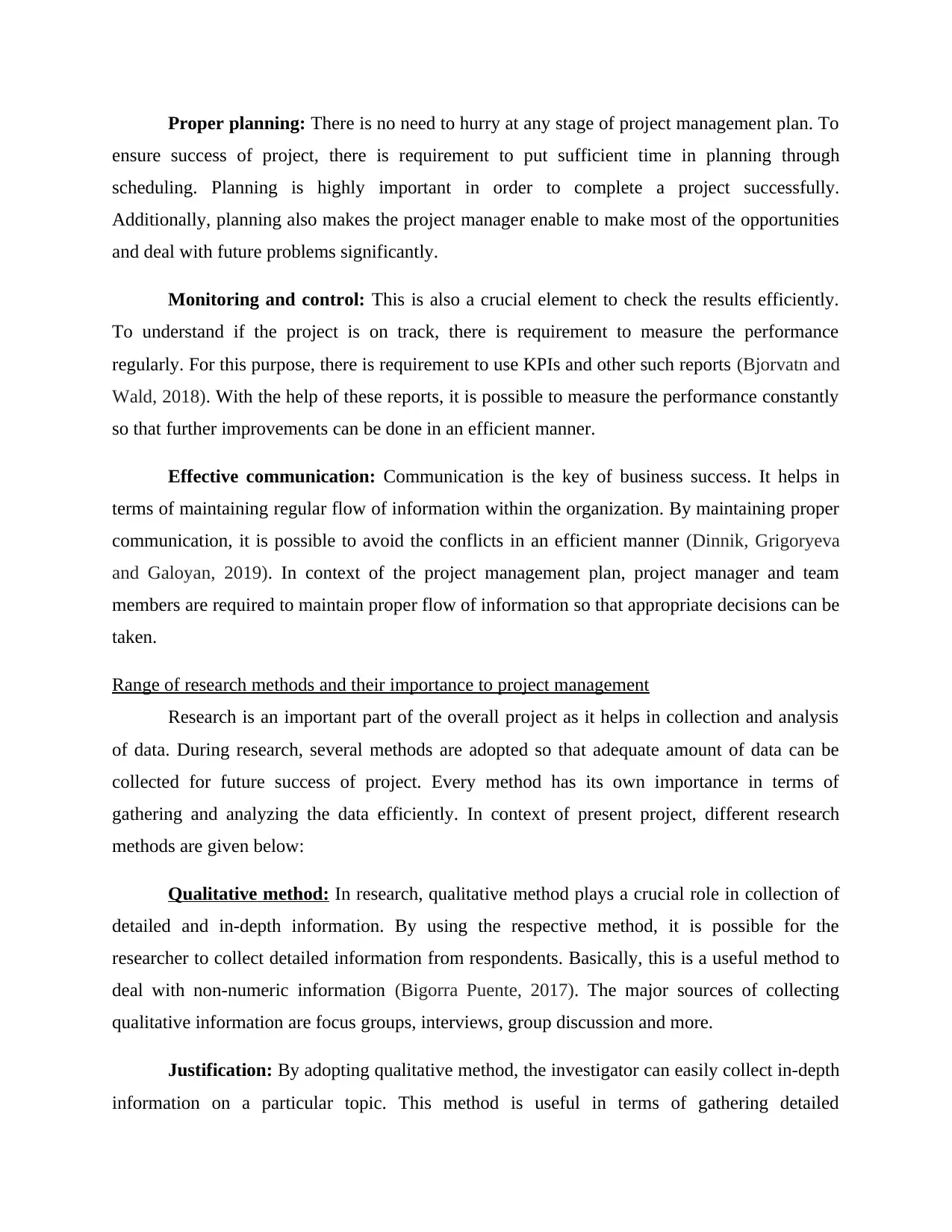
Proper planning: There is no need to hurry at any stage of project management plan. To
ensure success of project, there is requirement to put sufficient time in planning through
scheduling. Planning is highly important in order to complete a project successfully.
Additionally, planning also makes the project manager enable to make most of the opportunities
and deal with future problems significantly.
Monitoring and control: This is also a crucial element to check the results efficiently.
To understand if the project is on track, there is requirement to measure the performance
regularly. For this purpose, there is requirement to use KPIs and other such reports (Bjorvatn and
Wald, 2018). With the help of these reports, it is possible to measure the performance constantly
so that further improvements can be done in an efficient manner.
Effective communication: Communication is the key of business success. It helps in
terms of maintaining regular flow of information within the organization. By maintaining proper
communication, it is possible to avoid the conflicts in an efficient manner (Dinnik, Grigoryeva
and Galoyan, 2019). In context of the project management plan, project manager and team
members are required to maintain proper flow of information so that appropriate decisions can be
taken.
Range of research methods and their importance to project management
Research is an important part of the overall project as it helps in collection and analysis
of data. During research, several methods are adopted so that adequate amount of data can be
collected for future success of project. Every method has its own importance in terms of
gathering and analyzing the data efficiently. In context of present project, different research
methods are given below:
Qualitative method: In research, qualitative method plays a crucial role in collection of
detailed and in-depth information. By using the respective method, it is possible for the
researcher to collect detailed information from respondents. Basically, this is a useful method to
deal with non-numeric information (Bigorra Puente, 2017). The major sources of collecting
qualitative information are focus groups, interviews, group discussion and more.
Justification: By adopting qualitative method, the investigator can easily collect in-depth
information on a particular topic. This method is useful in terms of gathering detailed
ensure success of project, there is requirement to put sufficient time in planning through
scheduling. Planning is highly important in order to complete a project successfully.
Additionally, planning also makes the project manager enable to make most of the opportunities
and deal with future problems significantly.
Monitoring and control: This is also a crucial element to check the results efficiently.
To understand if the project is on track, there is requirement to measure the performance
regularly. For this purpose, there is requirement to use KPIs and other such reports (Bjorvatn and
Wald, 2018). With the help of these reports, it is possible to measure the performance constantly
so that further improvements can be done in an efficient manner.
Effective communication: Communication is the key of business success. It helps in
terms of maintaining regular flow of information within the organization. By maintaining proper
communication, it is possible to avoid the conflicts in an efficient manner (Dinnik, Grigoryeva
and Galoyan, 2019). In context of the project management plan, project manager and team
members are required to maintain proper flow of information so that appropriate decisions can be
taken.
Range of research methods and their importance to project management
Research is an important part of the overall project as it helps in collection and analysis
of data. During research, several methods are adopted so that adequate amount of data can be
collected for future success of project. Every method has its own importance in terms of
gathering and analyzing the data efficiently. In context of present project, different research
methods are given below:
Qualitative method: In research, qualitative method plays a crucial role in collection of
detailed and in-depth information. By using the respective method, it is possible for the
researcher to collect detailed information from respondents. Basically, this is a useful method to
deal with non-numeric information (Bigorra Puente, 2017). The major sources of collecting
qualitative information are focus groups, interviews, group discussion and more.
Justification: By adopting qualitative method, the investigator can easily collect in-depth
information on a particular topic. This method is useful in terms of gathering detailed
Paraphrase This Document
Need a fresh take? Get an instant paraphrase of this document with our AI Paraphraser
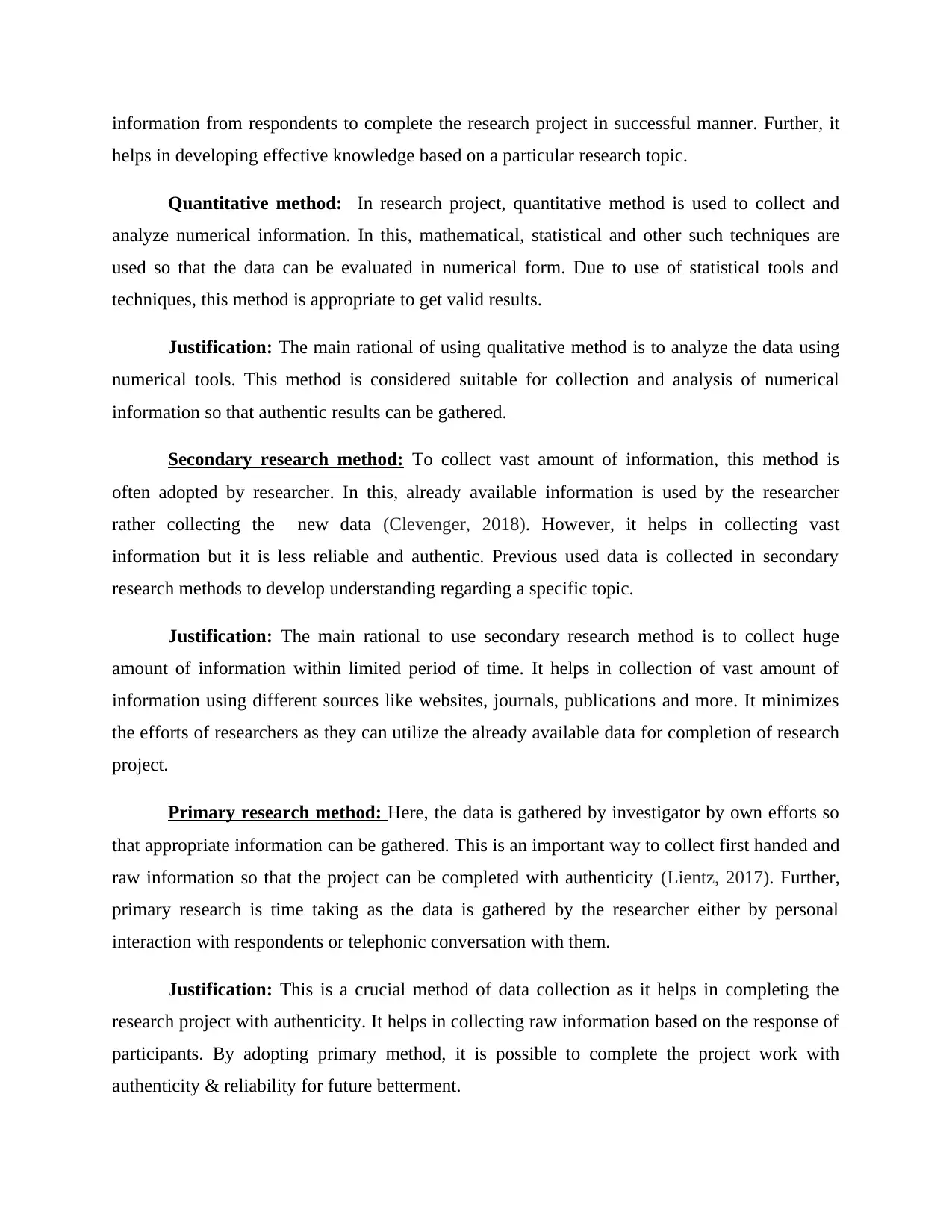
information from respondents to complete the research project in successful manner. Further, it
helps in developing effective knowledge based on a particular research topic.
Quantitative method: In research project, quantitative method is used to collect and
analyze numerical information. In this, mathematical, statistical and other such techniques are
used so that the data can be evaluated in numerical form. Due to use of statistical tools and
techniques, this method is appropriate to get valid results.
Justification: The main rational of using qualitative method is to analyze the data using
numerical tools. This method is considered suitable for collection and analysis of numerical
information so that authentic results can be gathered.
Secondary research method: To collect vast amount of information, this method is
often adopted by researcher. In this, already available information is used by the researcher
rather collecting the new data (Clevenger, 2018). However, it helps in collecting vast
information but it is less reliable and authentic. Previous used data is collected in secondary
research methods to develop understanding regarding a specific topic.
Justification: The main rational to use secondary research method is to collect huge
amount of information within limited period of time. It helps in collection of vast amount of
information using different sources like websites, journals, publications and more. It minimizes
the efforts of researchers as they can utilize the already available data for completion of research
project.
Primary research method: Here, the data is gathered by investigator by own efforts so
that appropriate information can be gathered. This is an important way to collect first handed and
raw information so that the project can be completed with authenticity (Lientz, 2017). Further,
primary research is time taking as the data is gathered by the researcher either by personal
interaction with respondents or telephonic conversation with them.
Justification: This is a crucial method of data collection as it helps in completing the
research project with authenticity. It helps in collecting raw information based on the response of
participants. By adopting primary method, it is possible to complete the project work with
authenticity & reliability for future betterment.
helps in developing effective knowledge based on a particular research topic.
Quantitative method: In research project, quantitative method is used to collect and
analyze numerical information. In this, mathematical, statistical and other such techniques are
used so that the data can be evaluated in numerical form. Due to use of statistical tools and
techniques, this method is appropriate to get valid results.
Justification: The main rational of using qualitative method is to analyze the data using
numerical tools. This method is considered suitable for collection and analysis of numerical
information so that authentic results can be gathered.
Secondary research method: To collect vast amount of information, this method is
often adopted by researcher. In this, already available information is used by the researcher
rather collecting the new data (Clevenger, 2018). However, it helps in collecting vast
information but it is less reliable and authentic. Previous used data is collected in secondary
research methods to develop understanding regarding a specific topic.
Justification: The main rational to use secondary research method is to collect huge
amount of information within limited period of time. It helps in collection of vast amount of
information using different sources like websites, journals, publications and more. It minimizes
the efforts of researchers as they can utilize the already available data for completion of research
project.
Primary research method: Here, the data is gathered by investigator by own efforts so
that appropriate information can be gathered. This is an important way to collect first handed and
raw information so that the project can be completed with authenticity (Lientz, 2017). Further,
primary research is time taking as the data is gathered by the researcher either by personal
interaction with respondents or telephonic conversation with them.
Justification: This is a crucial method of data collection as it helps in completing the
research project with authenticity. It helps in collecting raw information based on the response of
participants. By adopting primary method, it is possible to complete the project work with
authenticity & reliability for future betterment.
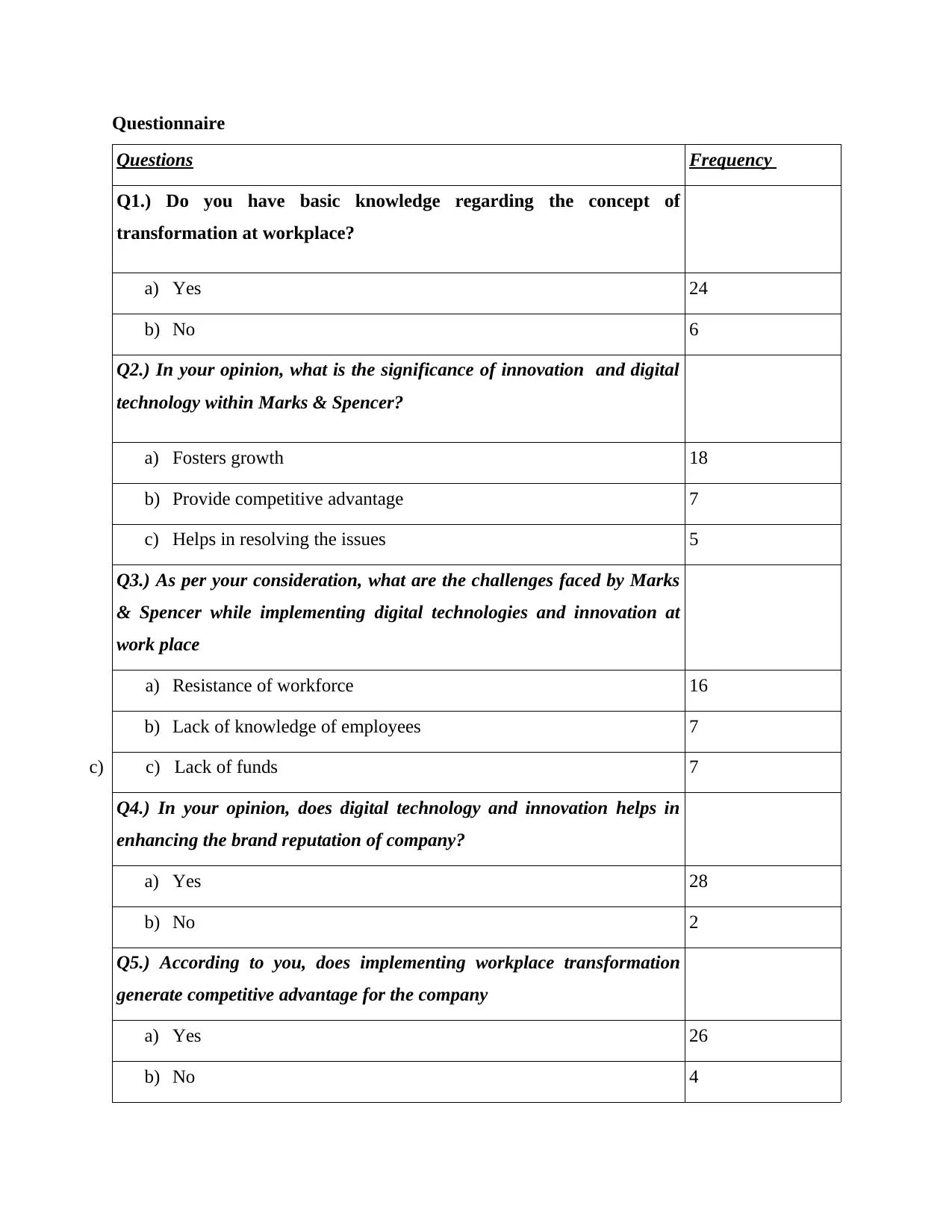
Questionnaire
Questions Frequency
Q1.) Do you have basic knowledge regarding the concept of
transformation at workplace?
a) Yes 24
b) No 6
Q2.) In your opinion, what is the significance of innovation and digital
technology within Marks & Spencer?
a) Fosters growth 18
b) Provide competitive advantage 7
c) Helps in resolving the issues 5
Q3.) As per your consideration, what are the challenges faced by Marks
& Spencer while implementing digital technologies and innovation at
work place
a) Resistance of workforce 16
b) Lack of knowledge of employees 7
c) c) Lack of funds 7
Q4.) In your opinion, does digital technology and innovation helps in
enhancing the brand reputation of company?
a) Yes 28
b) No 2
Q5.) According to you, does implementing workplace transformation
generate competitive advantage for the company
a) Yes 26
b) No 4
Questions Frequency
Q1.) Do you have basic knowledge regarding the concept of
transformation at workplace?
a) Yes 24
b) No 6
Q2.) In your opinion, what is the significance of innovation and digital
technology within Marks & Spencer?
a) Fosters growth 18
b) Provide competitive advantage 7
c) Helps in resolving the issues 5
Q3.) As per your consideration, what are the challenges faced by Marks
& Spencer while implementing digital technologies and innovation at
work place
a) Resistance of workforce 16
b) Lack of knowledge of employees 7
c) c) Lack of funds 7
Q4.) In your opinion, does digital technology and innovation helps in
enhancing the brand reputation of company?
a) Yes 28
b) No 2
Q5.) According to you, does implementing workplace transformation
generate competitive advantage for the company
a) Yes 26
b) No 4
⊘ This is a preview!⊘
Do you want full access?
Subscribe today to unlock all pages.

Trusted by 1+ million students worldwide
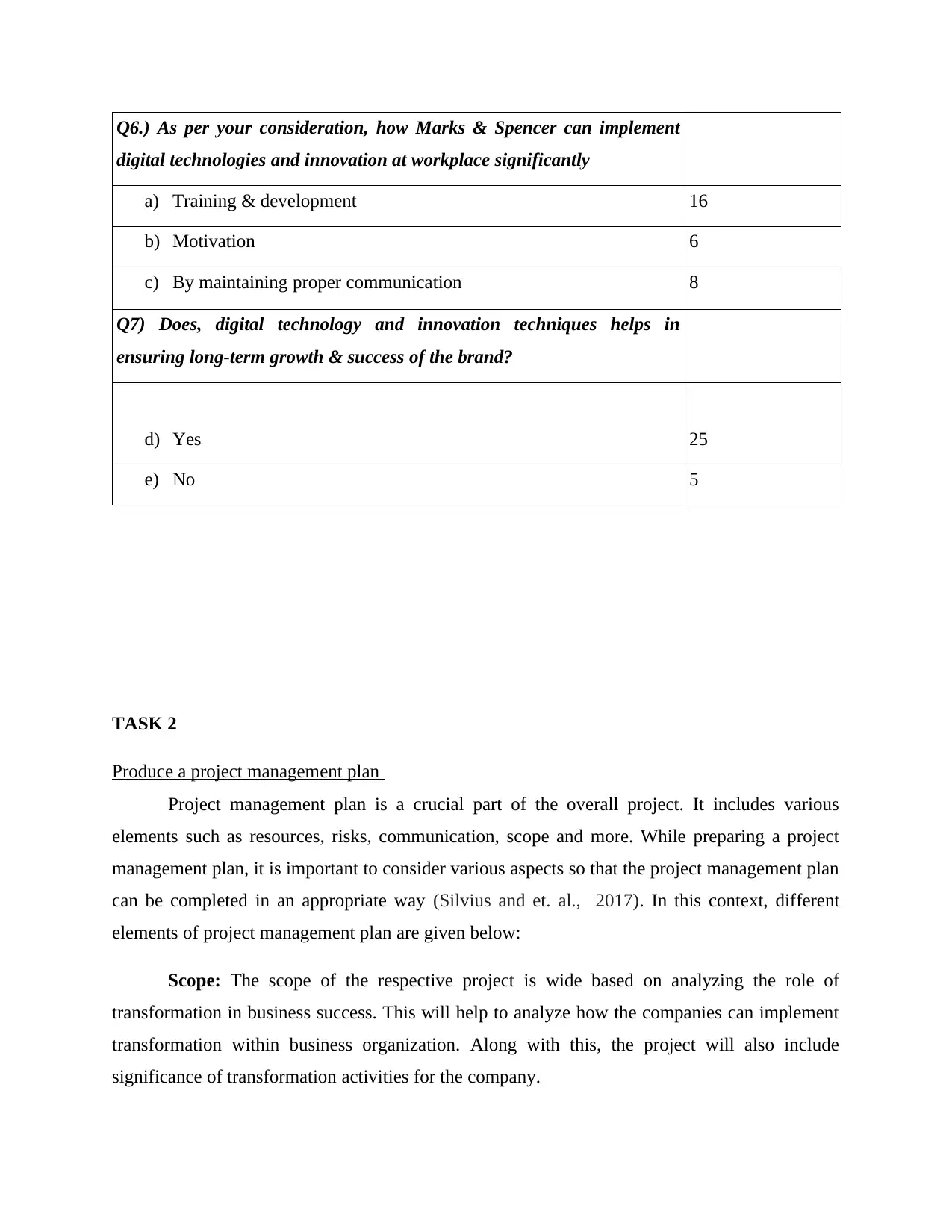
Q6.) As per your consideration, how Marks & Spencer can implement
digital technologies and innovation at workplace significantly
a) Training & development 16
b) Motivation 6
c) By maintaining proper communication 8
Q7) Does, digital technology and innovation techniques helps in
ensuring long-term growth & success of the brand?
d) Yes 25
e) No 5
TASK 2
Produce a project management plan
Project management plan is a crucial part of the overall project. It includes various
elements such as resources, risks, communication, scope and more. While preparing a project
management plan, it is important to consider various aspects so that the project management plan
can be completed in an appropriate way (Silvius and et. al., 2017). In this context, different
elements of project management plan are given below:
Scope: The scope of the respective project is wide based on analyzing the role of
transformation in business success. This will help to analyze how the companies can implement
transformation within business organization. Along with this, the project will also include
significance of transformation activities for the company.
digital technologies and innovation at workplace significantly
a) Training & development 16
b) Motivation 6
c) By maintaining proper communication 8
Q7) Does, digital technology and innovation techniques helps in
ensuring long-term growth & success of the brand?
d) Yes 25
e) No 5
TASK 2
Produce a project management plan
Project management plan is a crucial part of the overall project. It includes various
elements such as resources, risks, communication, scope and more. While preparing a project
management plan, it is important to consider various aspects so that the project management plan
can be completed in an appropriate way (Silvius and et. al., 2017). In this context, different
elements of project management plan are given below:
Scope: The scope of the respective project is wide based on analyzing the role of
transformation in business success. This will help to analyze how the companies can implement
transformation within business organization. Along with this, the project will also include
significance of transformation activities for the company.
Paraphrase This Document
Need a fresh take? Get an instant paraphrase of this document with our AI Paraphraser
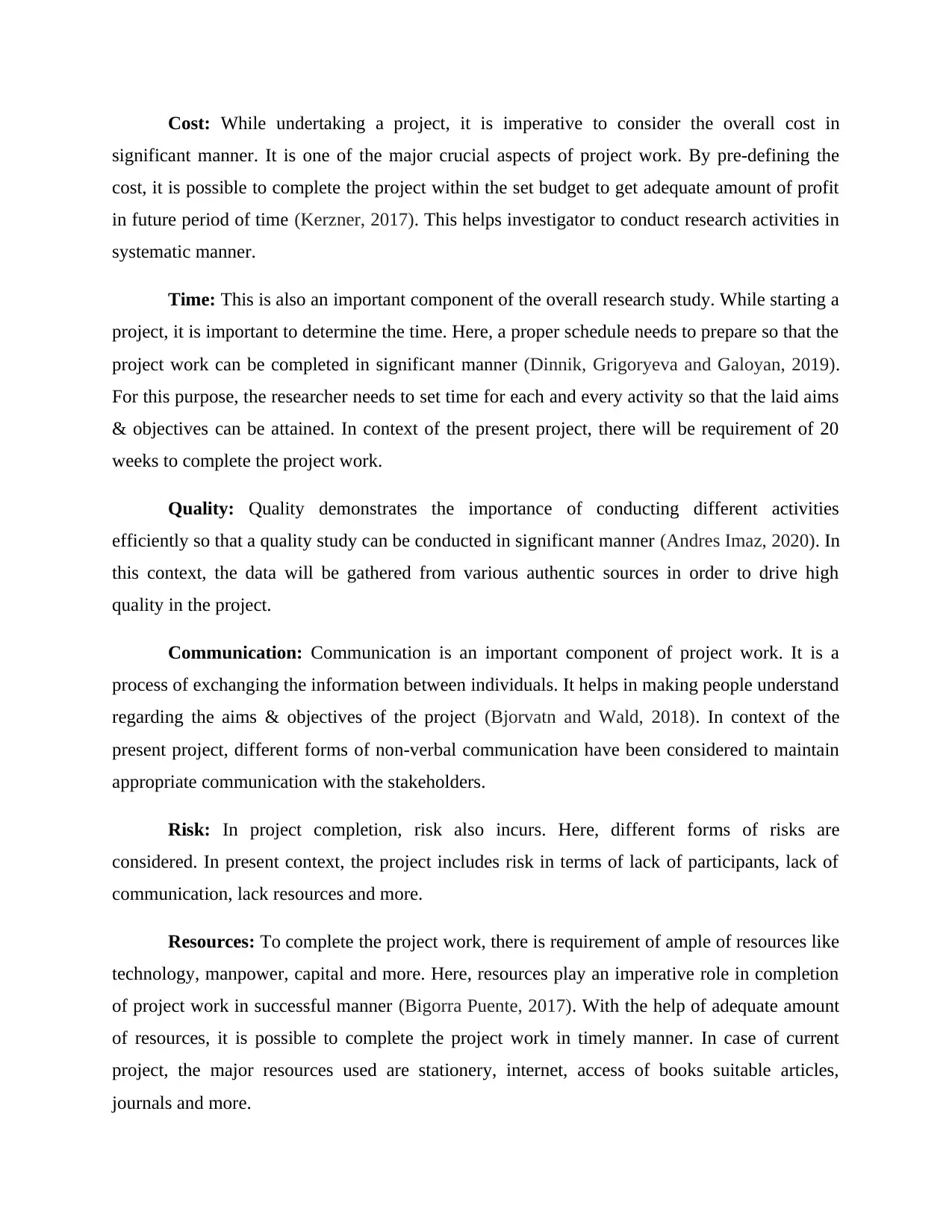
Cost: While undertaking a project, it is imperative to consider the overall cost in
significant manner. It is one of the major crucial aspects of project work. By pre-defining the
cost, it is possible to complete the project within the set budget to get adequate amount of profit
in future period of time (Kerzner, 2017). This helps investigator to conduct research activities in
systematic manner.
Time: This is also an important component of the overall research study. While starting a
project, it is important to determine the time. Here, a proper schedule needs to prepare so that the
project work can be completed in significant manner (Dinnik, Grigoryeva and Galoyan, 2019).
For this purpose, the researcher needs to set time for each and every activity so that the laid aims
& objectives can be attained. In context of the present project, there will be requirement of 20
weeks to complete the project work.
Quality: Quality demonstrates the importance of conducting different activities
efficiently so that a quality study can be conducted in significant manner (Andres Imaz, 2020). In
this context, the data will be gathered from various authentic sources in order to drive high
quality in the project.
Communication: Communication is an important component of project work. It is a
process of exchanging the information between individuals. It helps in making people understand
regarding the aims & objectives of the project (Bjorvatn and Wald, 2018). In context of the
present project, different forms of non-verbal communication have been considered to maintain
appropriate communication with the stakeholders.
Risk: In project completion, risk also incurs. Here, different forms of risks are
considered. In present context, the project includes risk in terms of lack of participants, lack of
communication, lack resources and more.
Resources: To complete the project work, there is requirement of ample of resources like
technology, manpower, capital and more. Here, resources play an imperative role in completion
of project work in successful manner (Bigorra Puente, 2017). With the help of adequate amount
of resources, it is possible to complete the project work in timely manner. In case of current
project, the major resources used are stationery, internet, access of books suitable articles,
journals and more.
significant manner. It is one of the major crucial aspects of project work. By pre-defining the
cost, it is possible to complete the project within the set budget to get adequate amount of profit
in future period of time (Kerzner, 2017). This helps investigator to conduct research activities in
systematic manner.
Time: This is also an important component of the overall research study. While starting a
project, it is important to determine the time. Here, a proper schedule needs to prepare so that the
project work can be completed in significant manner (Dinnik, Grigoryeva and Galoyan, 2019).
For this purpose, the researcher needs to set time for each and every activity so that the laid aims
& objectives can be attained. In context of the present project, there will be requirement of 20
weeks to complete the project work.
Quality: Quality demonstrates the importance of conducting different activities
efficiently so that a quality study can be conducted in significant manner (Andres Imaz, 2020). In
this context, the data will be gathered from various authentic sources in order to drive high
quality in the project.
Communication: Communication is an important component of project work. It is a
process of exchanging the information between individuals. It helps in making people understand
regarding the aims & objectives of the project (Bjorvatn and Wald, 2018). In context of the
present project, different forms of non-verbal communication have been considered to maintain
appropriate communication with the stakeholders.
Risk: In project completion, risk also incurs. Here, different forms of risks are
considered. In present context, the project includes risk in terms of lack of participants, lack of
communication, lack resources and more.
Resources: To complete the project work, there is requirement of ample of resources like
technology, manpower, capital and more. Here, resources play an imperative role in completion
of project work in successful manner (Bigorra Puente, 2017). With the help of adequate amount
of resources, it is possible to complete the project work in timely manner. In case of current
project, the major resources used are stationery, internet, access of books suitable articles,
journals and more.
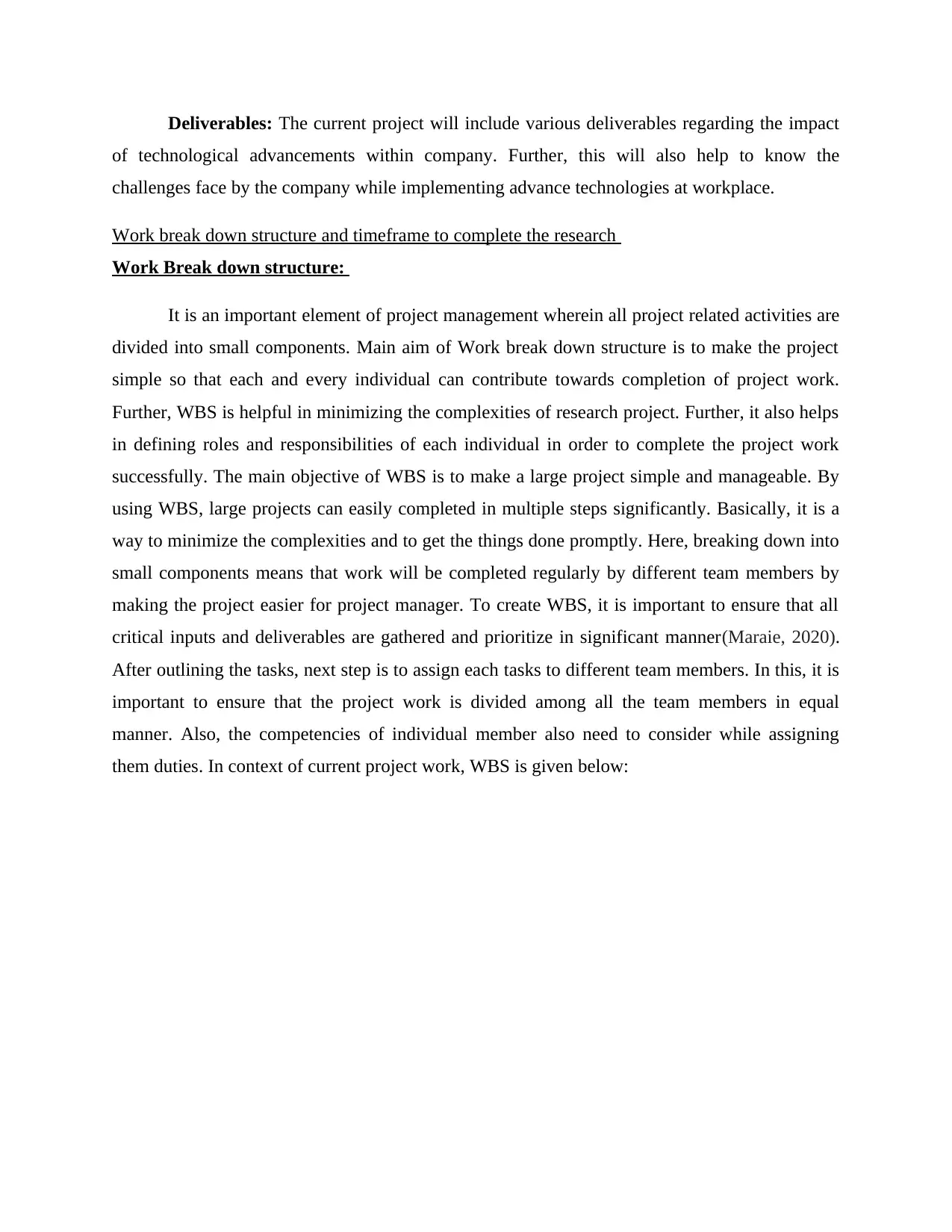
Deliverables: The current project will include various deliverables regarding the impact
of technological advancements within company. Further, this will also help to know the
challenges face by the company while implementing advance technologies at workplace.
Work break down structure and timeframe to complete the research
Work Break down structure:
It is an important element of project management wherein all project related activities are
divided into small components. Main aim of Work break down structure is to make the project
simple so that each and every individual can contribute towards completion of project work.
Further, WBS is helpful in minimizing the complexities of research project. Further, it also helps
in defining roles and responsibilities of each individual in order to complete the project work
successfully. The main objective of WBS is to make a large project simple and manageable. By
using WBS, large projects can easily completed in multiple steps significantly. Basically, it is a
way to minimize the complexities and to get the things done promptly. Here, breaking down into
small components means that work will be completed regularly by different team members by
making the project easier for project manager. To create WBS, it is important to ensure that all
critical inputs and deliverables are gathered and prioritize in significant manner(Maraie, 2020).
After outlining the tasks, next step is to assign each tasks to different team members. In this, it is
important to ensure that the project work is divided among all the team members in equal
manner. Also, the competencies of individual member also need to consider while assigning
them duties. In context of current project work, WBS is given below:
of technological advancements within company. Further, this will also help to know the
challenges face by the company while implementing advance technologies at workplace.
Work break down structure and timeframe to complete the research
Work Break down structure:
It is an important element of project management wherein all project related activities are
divided into small components. Main aim of Work break down structure is to make the project
simple so that each and every individual can contribute towards completion of project work.
Further, WBS is helpful in minimizing the complexities of research project. Further, it also helps
in defining roles and responsibilities of each individual in order to complete the project work
successfully. The main objective of WBS is to make a large project simple and manageable. By
using WBS, large projects can easily completed in multiple steps significantly. Basically, it is a
way to minimize the complexities and to get the things done promptly. Here, breaking down into
small components means that work will be completed regularly by different team members by
making the project easier for project manager. To create WBS, it is important to ensure that all
critical inputs and deliverables are gathered and prioritize in significant manner(Maraie, 2020).
After outlining the tasks, next step is to assign each tasks to different team members. In this, it is
important to ensure that the project work is divided among all the team members in equal
manner. Also, the competencies of individual member also need to consider while assigning
them duties. In context of current project work, WBS is given below:
⊘ This is a preview!⊘
Do you want full access?
Subscribe today to unlock all pages.

Trusted by 1+ million students worldwide
1 out of 26
Related Documents
Your All-in-One AI-Powered Toolkit for Academic Success.
+13062052269
info@desklib.com
Available 24*7 on WhatsApp / Email
![[object Object]](/_next/static/media/star-bottom.7253800d.svg)
Unlock your academic potential
Copyright © 2020–2025 A2Z Services. All Rights Reserved. Developed and managed by ZUCOL.




